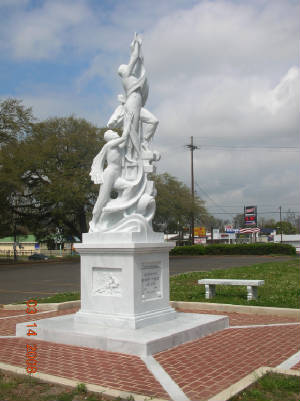
Joseph Verbis Lafleur was born into a large Cajun family in Ville Platte Louisiana on January 24, 1912. From early childhood his ambition was to be a priest. Entering Saint Joseph’s Minor Seminary in Saint Benedict, Louisiana he quickly became noted for his good humor, quick wit and athletic prowess. He also had a marked interest in French military history and would recite the last words of Marshal Michel Ney before his execution by the restored Bourbons after the Hundred Days: “Come see how a soldier dies in battle, but he dies not.”
Ordained in 1938 he was assigned as assistant pastor at Saint Mary Magdalene in Abbeville, Louisiana. Depression era Louisiana knew poverty that people today would find hard to believe. Father Lafleur supplied balls, bats and gloves to the boys in his parish and helped organize baseball games. After his death some of the boys learned that Father Lafleur had purchased the equipment by pawning his wristwatch.
Father LaFleur joined the Army Air Corps in 1941 over six months before Pearl Harbor. Four months later Lieutenant LaFleur was sent with the 19th Bombardment Group to Clark Field in the Philippines. The new chaplain was popular with the men: he helped organize a baseball team, founded a discussion group and his door was always open to them.
On December 8, 1941 the Japanese attacked Clark Field and Chaplain LaFleur sprang into action. Ignoring exploding bombs and flying shrapnel he helped treat the wounded and administered the Last Rites to those beyond human help. For his actions that day he was awarded the Distinguished Service Cross.
As the Philippines were conquered by the Japanese Father LaFleur passed up an opportunity for evacuation, stating that his place was with the men.
Over one-third of all Allied POWs in Japanese hands died. Death from starvation, at the hands of the brutal guards or disease was a constant fact of life for every prisoner of the Rising Sun. Into this hell on earth Chaplain Lafleur brought Christ. So long as he had a little bread and wine he said mass for his fellow prisoners. While in captivity at Davoa Father Lafleur built a makeshift chapel which he called Saint Peter in Chairs. His fellow POWs flocked to his services, Catholic and non-Catholic alike.
As best he could Father LaFleur also ministered to the physical needs of his flock. He would continually visit and assist the many sick. He would often exchange his clothes for those worn by another prisoner if Father LaFleur thought that the other prisoner would benefit by the exchange. Most movingly, in a setting where all the prisoners were being slowly starved to death, the Chaplain would give away some of his own food to help out men who seemed to need it. Moved by this superhuman charity, other prisoners began to give to Father LaFleur pieces of their own clothing and scraps of their own food for him to distribute.
Father LaFleur believed in a muscular form of Christianity. Learning that a healthy prisoner was stealing food from the sick, he fought the man, defeated him, and was then carried through the camp by his cheering men.
As the war progressively turned against Japan, orders came out from the Japanese High Command to begin shipping POWs back to Japan to serve as slave labor. Father LaFleur and 749 other prisoners were on board the ship the Shiniyo Maru when the USS Paddlefish torpedoed it off the coast of Mindanao on September 7, 1944. The sinking occurred because the Japanese adamantly refused throughout the war to indicate when a ship was carrying POWs. Father LaFleur, despite the urgings of his fellow captives, refused to leave the ship’s hold, instead holding the ladder so that other men could attempt to climb out of the hold and escape. That was the last anyone ever saw on this Earth of Father LaFleur.
If you are ever in Opelousas Louisiana, stop by Saint Landry. They have a beautiful monument to Father LaFleur.

There is a plaque to Father LaFleur at the Notre Dame seminary in New Orleans: It is inscribed:
“Venez voir comment meurt un pretre en bataille …mais il ne meurt pas.” – “Come, see how a priest dies in battle, but he dies not.”

Wow. That’s some story.
One we would all like to emulate, but never will.
Actions………….
Indeed Don. Father LaFleur gives us something to shoot for in our lives, no matter how far off we may fail in our day to day living.
What an incredibly moving story. Thank you for sharing this with us Donald.
Magnifcent. Much in the spirit of Father Damien, who will get the Big Halo October 11. Don- nice work by you again.
Thank you Tito and Gerard. We have had many valiant and good Catholic chaplains in service to our country, and I plan to write about as many of them as I can.
Their stories should be heard and celebrated as shining examples of following in the footsteps of our Lord.
Thank you. But, “Saint Peter in Chairs” ummm?
I thought that was odd too Ronald. One would have thought Saint Peter in Chains. However Father LaFleur did have a robust sense of humor!
What a wonderful story. Unfortunately the date of the Pearl Harbor attack is wrong.It was December 7th not 8th as stated.
Thank you for your kind comment Noreen. You are correct that the attack on Pearl Harbor took place on December 7, 1941. However the attack on Clark Field in the Philippines, where Father LaFleur was stationed, took place on December 8.
http://www.pacificwrecks.com/airfields/philippines/clark/index.html
Hey thanx for posting.